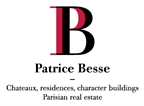A 1950s house with 19th-century outbuildings, 12 km from Rouen, with almost 20 hectares of grounds, woods and meadows - ref 991649
A 1950s house with 19th-century outbuildings, 12 km from Rouen, with almost 20 hectares of grounds, woods and meadows.
This 20-hectare property is located in the south of the Pays de Caux area, 7 km as birds fly from a meander in the River Seine, in the middle of a small town. The surrounding environment is made up of open fields dotted with tree-filled villages as well as fenced hoves with tall trees. In addition, the Boucles de la Seine regional natural park is not far away, as is the Seine estuary nature reserve. Convenience shops are just 2 kilometres away, while Paris can be reached in 2 hours by train or motorway.
After the Second World War, the mansion built in the centre of the property was requisitioned by the Americans, after the German occupation. For greater comfort, they demolished load-bearing walls which damaged the edifice, eventually resulting in its destruction. A modern house of traditional appearance, with rendered façades, roof made of local tiles and gable dormers was thus built in the middle of the 20th century where the previous building had stood. This two-storey, southeast facing dwelling overlooking a patio is vast, comfortable and has been designed in every way to accommodate a large family.
Additionally, at the entrance to the estate, there is an estate keeper's house. A long drive winds through the woods and then vast lawns before reaching a large, gravelled area in front of the house.
Beyond the woods, a meadow planted with apple trees surrounds a vast barn and a dovecote.
Lastly, to the rear of the residence, behind the tall trees, there is a stable, its adjoining accommodation and the entrance to the vegetable garden that the estate possesses. The various outbuildings, built between 1855 and 1865, have the same characteristics: spacious, built in ashlar, flint and brick. The quality of their construction can be seen in the many decorative details.
The houseIt has two storeys and a cellar, with a flat-tiled, hipped roof, dotted with gable dormers and topped with brick chimney stacks. The large-paned windows on the first level, which are semi-circular arched in the middle of the building and rectangular at the sides, where the façade protrudes slightly, are fitted with blue-painted, wooden louvred shutters.
The ground floor
The entrance, paved with large, light-coloured tiles and black taco tiling, leads to an office and a lounge, on one side, and to a cloakroom with a lavatory, as well as the kitchen and dining room on the other. Two bedrooms standing one next to another can be reached from both rooms to the rear. One of them has an en suite bathroom. Thanks to the many windows, this level is generously bathed in light, especially the reception rooms, which are separated by large wooden sliding doors and from where the patio can be reached through semi-circular arched French windows. There is mosaic wooden flooring in this room.
The upstairs
The upper floor has a slightly sloping roof and gable dormers allow light to stream in. The wooden staircase with a wrought-iron balustrade leads to a landing and then, on either side, to two wide corridors. One of them leads to three bedrooms, each of which has a washbasin, and to a shower room. On the other side, the second corridor leads to two rooms set one after another, used as a utility room and laundry room, as well as two bedrooms and a bathroom. The same flooring as on the ground floor can be found throughout.
The basement
This level spreads out under most of the house (which has a crawl space under the lounge). The walls are made of blocks of flint and there is a concrete floor. There are several rooms, used as a boiler room, storage space and a wine cellar, which has a gravel floor to help regulate humidity and help preserve the bottles' content.


